This article needs additional citations for verification .(May 2022) |
Uriah (or Urijah in some older English translations) is a prophet and martyr mentioned in the Book of Jeremiah. [1]
This article needs additional citations for verification .(May 2022) |
Uriah (or Urijah in some older English translations) is a prophet and martyr mentioned in the Book of Jeremiah. [1]
He is described as being the son of Shemaiah from Kiriath-Jearim. During the reign of Jehoiakim, king of Judah, he fled into Egypt from the cruelty of the king, but having been brought back he was beheaded and his body "cast into the graves of the common people."
While not is not certain, there is a scholarly opinion that Uriah might be referenced in the Lachish letters. See Lachish letters.

The Kingdom of Judah was an Israelite kingdom of the Southern Levant during the Iron Age. Centered in Judea, the kingdom's capital was Jerusalem. The other Israelite polity, the Kingdom of Israel, lay to the north. Jews are named after Judah and are primarily descended from it.
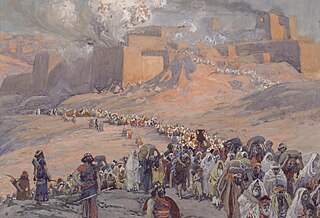
The Babylonian captivity or Babylonian exile is the period in Jewish history during which a large number of Judeans from the ancient Kingdom of Judah were captives in Babylon, the capital city of the Neo-Babylonian Empire, following their defeat in the Jewish–Babylonian War and the destruction of Solomon's Temple in Jerusalem. The event is described in the Hebrew Bible, and its historicity is supported by archaeological and non-biblical evidence.
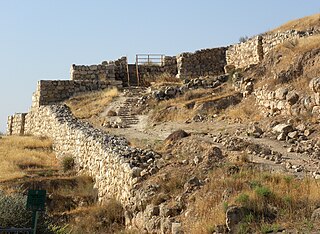
Lachish was an ancient Canaanite and Israelite city in the Shephelah region of Israel, on the South bank of the Lakhish River, mentioned several times in the Hebrew Bible. The current tell (ruin) by that name, known as Tel Lachish or Tell ed-Duweir ,, has been identified with the biblical Lachish. Today, it is an Israeli national park operated and maintained by the Israel Nature and Parks Authority. The park was established on lands of the depopulated Palestinian village of Qobebet Ibn ‘Awwad which was north of the Tel. It lies near the present-day moshav of Lakhish.
Uriah or Uriyah is a Hebrew given name. It may refer to:
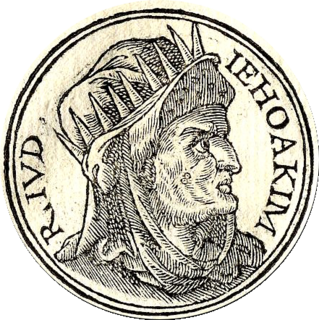
Jehoiakim, also sometimes spelled Jehoikim was the eighteenth and antepenultimate king of Judah from 609 to 598 BC. He was the second son of king Josiah and Zebidah, the daughter of Pedaiah of Rumah. His birth name was Eliakim.

Kiriath-Jearim was a city in the Land of Israel. It is mentioned 18 times in the Hebrew Bible. The biblical place was identified with Abu Ghosh.

LMLK seals are ancient Hebrew seals stamped on the handles of large storage jars first issued in the reign of King Hezekiah and discovered mostly in and around Jerusalem. Several complete jars were found in situ buried under a destruction layer caused by Sennacherib at Lachish. While none of the original seals have been found, some 2,000 impressions made by at least 21 seal types have been published. The iconography of the two and four winged symbols are representative of royal symbols whose meaning "was tailored in each kingdom to the local religion and ideology".
Libnah or Lobana was an independent city, probably near the western seaboard of Israel, with its own king at the time of the Israelite conquest of Canaan. It is thought to have been an important producer of revenue, and one that rebelled against the Judahite crown.

David Ussishkin is an Israeli archaeologist and professor emeritus of archaeology.
Rabsaris, possibly means "Chief of officers", is the name or title of two individuals mentioned in the Bible.
Zimredda was a leader of Lachish in the mid 14th century BC. He is mentioned in the Amarna letters, and is the author of EA 329,. Only two other references are made to "Zimredda of Lakiša"–(Lachish) in the corpus. He is part of the subject of letter EA 333, titled: "Plots and disloyalty" . His death is reported in EA 288 by Abdi-Heba–(letter no. 4 of 6), at the hands of the Habiru.
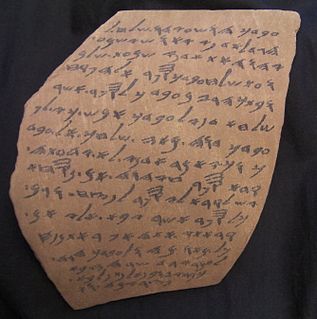
The Lachish Letters or Lachish Ostraca, sometimes called Hoshaiah Letters, are a series of letters written in carbon ink containing Canaanite inscriptions in Ancient Hebrew on clay ostraca. The letters were discovered at the excavations at Lachish.

The Lachish reliefs are a set of Assyrian palace reliefs narrating the story of the Assyrian victory over the kingdom of Judah during the siege of Lachish in 701 BCE. Carved between 700 and 681 BCE, as a decoration of the South-West Palace of Sennacherib in Nineveh, the relief is today in the British Museum in London, and was included as item 21 in the BBC Radio 4 series A History of the World in 100 Objects by the museum's former director Neil MacGregor. The palace room, where the relief was discovered in 1845–1847, was fully covered with the "Lachish relief" and was 12 metres (39 ft) wide and 5.10 metres (16.7 ft) long. The Lion Hunt of Ashurbanipal sequence was found in the same palace.
Moresheth-Gath, also Moreshet-Gat, was a town of the tribe of Judah in ancient Israel mentioned in the Bible. It was located in the Shephelah region between Lachish and Achzib.

Several kinds of archaeological remnants of the Jerusalem Temple exist. Those for what is customarily called Solomon's Temple are indirect and some are challenged. There is extensive physical evidence for the temple called the Second Temple that was built by returning exiles around 516 BCE and stood until its destruction by Rome in the year 70 CE.
The Anglican Province of Lokoja is one of the 14 ecclesiastical provinces of the Church of Nigeria. It comprises 11 dioceses. The Archbishop of the Anglican Province of Lokoja and Bishop of Minna is Daniel Abubakar Yisa. He was preceded by Emmanuel Sokowamju Egbunu.

2 Kings 19 is the nineteenth chapter of the second part of the Books of Kings in the Hebrew Bible or the Second Book of Kings in the Old Testament of the Christian Bible. The book is a compilation of various annals recording the acts of the kings of Israel and Judah by a Deuteronomic compiler in the seventh century BC, with a supplement added in the sixth century BC. This chapter records the invasion of Assyrian to Judah during the reign of Hezekiah, the king of Judah, a part of the section comprising 2 Kings 18:1 to 20:21, with a parallel version in Isaiah 36–39.
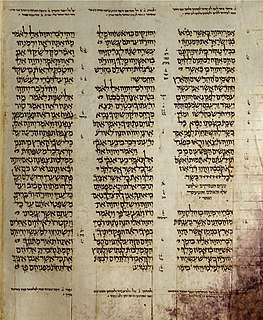
Jeremiah 38 is the thirty-eighth chapter of the Book of Jeremiah in the Hebrew Bible or the Old Testament of the Christian Bible. It is numbered as Jeremiah 45 in the Septuagint. This book contains prophecies attributed to the prophet Jeremiah, and is one of the Books of the Prophets. This chapter is part of a narrative section consisting of chapters 37 to 44. Chapter 38 records the petition from the royal officials to punish Jeremiah, his confinement in the dungeon or cistern and his rescue from there, although he remains in captivity, a secret conversation between Jeremiah and King Zedekiah, and the inquiry of Jeremiah by the king's officials.

Jeremiah 34 is the thirty-fourth chapter of the Book of Jeremiah in the Hebrew Bible or the Old Testament of the Christian Bible. It is numbered as Jeremiah 41 in the Septuagint. This book contains prophecies attributed to the prophet Jeremiah, and is one of the Books of the Prophets. This chapter anticipates the final moments in the assault of the Babylonian army against Jerusalem, when Jeremiah foretold the destruction of the city and the captivity of King Zedekiah, and sharply criticized the treacherous dealings of the princes and people with the slaves that provoked the punishment from God.